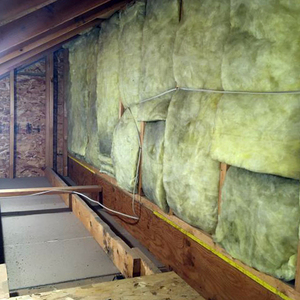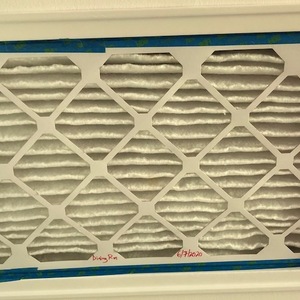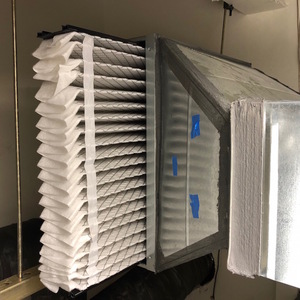
Over the past few months, I’ve taken a look at some critical issues for indoor air quality. Starting with the issue of how much time we spend indoors, I then wrote about kitchen ventilation, the panoply of indoor air pollutants, problems with filters in general and with high-MERV filters. Now let’s take the next step: a look at what research has been done on high-MERV filters and what can be done to overcome those unintended consequences I wrote about.
Study #1
Article: Residential AC Filters by John Proctor, ASHRAE Journal, October 2012.
In this article, John Proctor summarized some of the results he and his colleagues have found from studying California homes. One of the concerns in their research for the California Energy Commission was homeowners changing out 1-inch-thick standard fiberglass filters with 1-inch-thick pleated filters.
The Air Conditioning Contractors of America (ACCA) protocols for HVAC design assume a pressure drop of 0.10 inches of water column (i.w.c.) across the filter. (Keep that number, 0.1 i.w.c., in mind as a reference point. I’ll be coming back to it.) If a system is designed with a standard filter for that pressure drop, the pressure drop with a pleated filter of the same size will most likely be higher.
In addition, poorly designed and installed duct systems already have external static pressures that are too high. The typical furnace or air handler is rated for 0.5 i.w.c. but many run much higher pressure. David Richardson of the National Comfort Institute says that in the testing they’ve done, the average system is running at about 0.82 i.w.c.
Result: In the California study, Proctor et al. found that the pressure drop across the filter in 34 HVAC systems was 0.28 i.w.c. That’s nearly three times what ACCA protocols assume. It’s also more than half of the rated external static pressure for the whole system.
Study #2
Article: Is There a Downside to High-MERV Filters? by David Springer, Home Energy Magazine, 2 November 2009.
David Springer of the Davis Energy Group published this great article with a lot of detail about what they did and what they found, including blower energy use, compressor energy use, and the specific filters they tested. I’ll let you go there for the details because here I’m mainly going to focus on the issue of pressure drop across the filter and the resulting effect on air flow.
And speaking of filter pressure drop, here’s their chart for filters with MERV ratings from 2 to 13.

Results: As you can see, there’s not a steady increase in pressure drop as the MERV rating increases. What does happen, though, is that the pressure drop jumps up significantly as soon as you change from the standard 1″ fiberglass filter (MERV-2) to the next level at MERV-6.
They also found “a definite trend toward lower air flow with higher-MERV filters for systems using PSC motors.” (PSC stands for “permanent split capacitor.” A PSC motor is the one powering most HVAC blowers. Variable speed blowers have electronically commutated motors, ECMs.)
The final result I’ll mention here is that they didn’t see as much difference as they expected for filters of different depths. For example, “the 4-inch Filtrete 1550 (MERV 12) was only marginally better than the 1-inch Filtrete 1700 (also MERV 12) and the two other [1-inch] MERV 11 filters of the same brand (1000 and 1085).”
Study #3
Article: The Effects of Filtration on Pressure Drop and Energy Consumption in Residential HVAC Systems by Brent Stephens, Atila Novoselac, PhD, and Jeffrey A. Siegel, PhD, HVAC&R Research, Vol. 16, #3, May 2010.
This one is an academic paper so if you want all the details, equations, and references to other works, click the link above and download the paper. (Brent was a student at the time he wrote this paper and has a page on his filter research on his website at the Illinois Institute of Technology, if you want to dive even deeper.) They looked at filter pressure drop and energy consumption, both theoretically and using four months of data from two air conditioning systems in a test house in Austin, Texas.
Results: What they found is what you would expect, and in their limited range of MERV ratings tested, they did see an increase with each step up the MERV scale. Here are their results for filter pressure drop:
Low-MERV (<4) 0.10 i.w.c.
Mid-MERV (8) 0.19 i.w.c.
High-MERV (11) 0.32 i.w.c.
So the low-MERV filter is hitting the ACCA design pressure drop. The mid-MERV is twice as much and the high-MERV is three times as much.
They also found that air flow in the high-MERV filters dropped by 7% and 11% in the two HVAC systems compared to the low-MERV filters. Likewise, the mid-MERV filters also showed decreased air flow relative to the low-MERV filters, this time 3% and 8% lower in the two systems.
Summarizing the results
As you can see above, the research shows that in general, HVAC systems with high-MERV filters have a higher pressure drop across the filter. This part is common to all three studies above.
What happens with the air flow depends on what kind of blower the HVAC system uses. In a system with a PSC blower, the air flow drops and energy use doesn’t change much. The Stephens paper cites a 2002 study showing that 90% of all residential HVAC systems had PSC blowers. Certainly that number has fallen in the past 16 years, as high-performance homes and high-performance HVAC systems have become more popular. But I’m sure the vast majority of homes still have PSC motors running the blower.
For those with the other type, the electronically commutated motor (ECM), the controls on those motors typically ramp up the motor speed as the pressure increases so relatively constant air flow is maintained. But there’s a penalty. Blowers with ECMs can be more efficient than those with PSC motors when they’re operating against the pressure they’re designed for. But when the pressure is higher, they can end up using more energy than the PSC blower.
How to get good air flow AND good filtration
So what can you do to be able to use a high-MERV filter and not suffer a high pressure drop across the filter and the resulting loss of air flow (PSC blower) or increased energy use (ECM blower)? It’s actually pretty simple. You just have to make the filter large enough to have a low face velocity.
Remember my article on the continuity equation? As a duct gets larger in cross-sectional area, the velocity goes down. A lot of filters have a table printed on the side showing the pressure drop at a given air flow, and that’s something that you have to learn to use.
John Semmelhack, owner of the building science consulting firm Think Little in Charlottesville, Virginia, does this regularly because he has to. He designs and commissions a lot of ducted minisplit heat pumps that have very low external static pressure ratings. With a system rated for air flow at 0.20 i.w.c, you don’t want to give up even the ACCA recommended 0.10 i.w.c. So he goes for — and gets — 0.03 i.w.c. Yeah! Really! We’re in the process of having a Mitsubishi ducted minisplit installed in our office and that’s what we’re going for, too.
So, yes, most systems with high-MERV filters do have problems with excessive pressure drop across the filter and reduced air flow (or increased energy use). But that’s just because of lack of awareness of — or lack of interest in — how to do it properly.
Allison Bailes of Decatur, Georgia, is a speaker, writer, building science consultant, and the author of the Energy Vanguard Blog. You can follow him on Twitter at @EnergyVanguard.
Weekly Newsletter
Get building science and energy efficiency advice, plus special offers, in your inbox.















4 Comments
What I want to know is how much is .2 wc is an impact on my heat pump performance for my Mitsubishi split?
Steve,
If you're talking about a 0.2" w.c. pressure drop across the filter in a ducted mini-split rated for 0.2" w.c. total external static pressure (the SEZ model for Mitsubishi), it means you've used up all of the available pressure just to move air across the filter. The result of that will be higher energy usage because the ECM blower will ramp up to maintain the air flow. It'll probably also be noisier.
It's actually a PVA air handler. It'll do up to .8". But I've got a .2" filter, a .2" hydronic coil, and who knows how much resistance in actual ductwork...
I'm curious how much it'll effect my COP.
Out of curiosity let’s say a house has a 4 ton system and the owner wants to use a filter commonly found at the local store say the 20”x25”x1”Filtrete 1500 MERV 11. How many filters are needed to have enough surface area to get .010 i.w.c. and .003 i.w.c.?
Walta
Log in or create an account to post a comment.
Sign up Log in